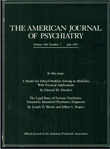Naltrexone-Induced Panic Attacks
TO THE EDITOR: Endogenous opioids have been related to anxiety disorders, and the opioid antagonist naltrexone has been reported to precipitate phobic behavior (1). We report a case of panic attacks precipitated by the administration of the opioid antagonist naltrexone.
Ms. A was a 29-year-old woman with bulimia nervosa who was enrolled in a clinical trial designed to evaluate naltrexone (100 mg/day) in the treatment of eating disorders. This patient had a family history of anxiety, but she had never suffered from any psychiatric disorder other than bulimia. Any accidental, medical, and/or recreational exposure to opiates was definitely ruled out. Before being enrolled in the study, the patient gave her written informed consent. She received 100 mg of naltrexone orally, and some hours later she experienced a state of alarm, demonstrating marked anxiety, chest discomfort, shortness of breath, profuse sweating, nausea, derealization, and fear of dying and of losing control. She was unable to stay at home alone or to go out without being accompanied. During the following 3 days she continued to take 100 mg of naltrexone as previously scheduled. However, the frequency of the panic attacks increased progressively, reaching a pattern of successive short bursts. On the fourth day, she came to the hospital in a state of alarm, manifesting fear of dying and of going crazy. She was treated with alprazolam (0.5 mg) and experienced partial relief of the symptoms. However, the day after, following a further dose of naltrexone, she experienced a relapse into bursts of panic attacks. Withdrawal of naltrexone led to complete remission of the panic symptoms in a couple of days. Since then, she has never experienced panic episodes.
Naltrexone is an opioid receptor antagonist that, like naloxone, has a marked affinity for µ opioid receptors. Since the late 1970s (2), several studies have suggested that panic attacks might be the consequence of hyperactivity of locus ceruleus noradrenergic cells. These neurons possess µ opioid receptors and are innervated by inhibitory fibers containing both enkefalins and endorphins (3). Similarly, exogenous opioid agonists, acting at µ receptors, produce inhibition of locus ceruleus cells (4). This pharmacological inhibition is reversed by opioid antagonists such as naloxone, which in turn produce hyperactivity of noradrenergic cells (5). In subjects in whom overactivity of endogenous opioids occurs, naltrexone might induce panic attacks by removing this inhibitory effect.
1. Arntz A, Merckelbach H, de Jong P: Opioid antagonist affects behavioral effects of exposure in vivo. J Consult Clin Psychol 1993; 61:865–870Crossref, Medline, Google Scholar
2. Redmond DE Jr, Huang YH: Current concepts, II: new evidence for a locus coeruleus-norepinephrine connection with anxiety. Life Sci 1979; 25:2149–2162Google Scholar
3. Strahlendorf HK, Strahlendorf JC, Barnes CD: Endorphin-mediated inhibition of locus coeruleus neurons. Brain Res 1980; 191:284–288Crossref, Medline, Google Scholar
4. Williams JT, Egan TM, North R: Enkephalin opens potassium channels in mammalian central neurones. Nature 1982; 299:74–76Crossref, Medline, Google Scholar
5. Aghajanian GK: Tolerance of locus coeruleus neurones to morphine and suppression of withdrawal response by clonidine. Nature 1978; 276:186–188Crossref, Medline, Google Scholar



